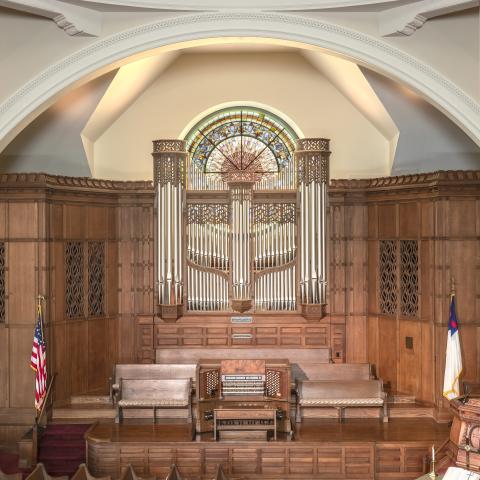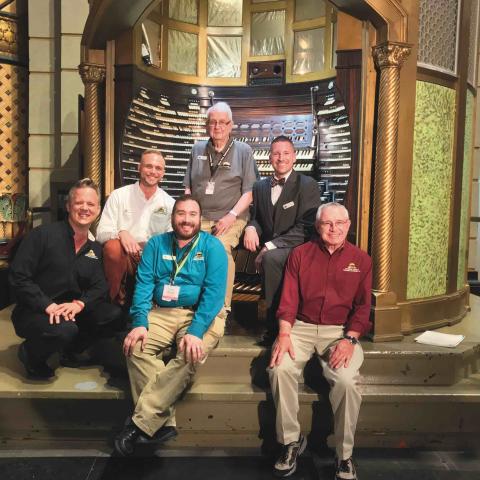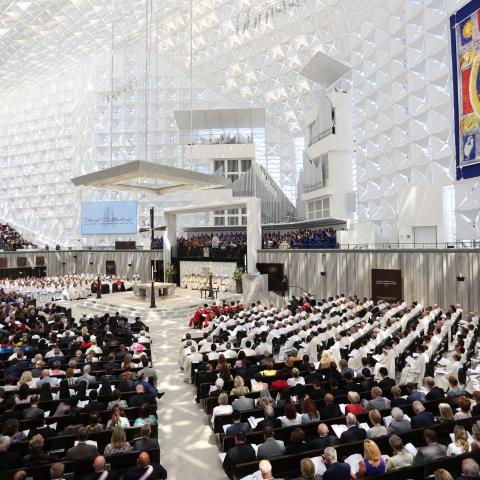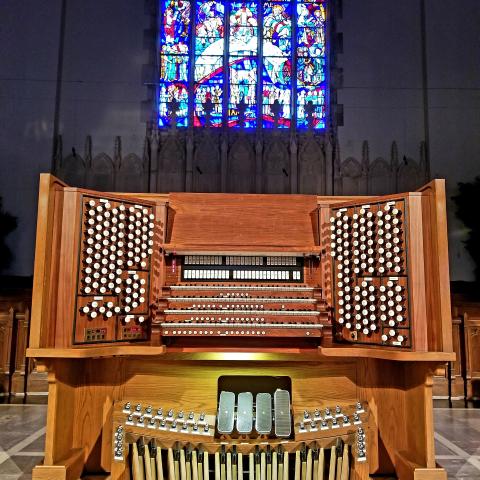Aeolian-Skinner Opus 892 restored by Foley-Baker
Michael Barone has worked at Minnesota Public Radio since 1968, for the first twenty-five years as music director and subsequently as host-producer of several nationally distributed programs including The Saint Paul Chamber Orchestra, A Festival of Nine Lessons and Carols, and Pipedreams. He has received significant awards from the American Guild of Organists, Organ Historical Society, and ASCAP, and has been inducted into the Minnesota Music Hall of Fame. Learn more at www.pipedreams.org.
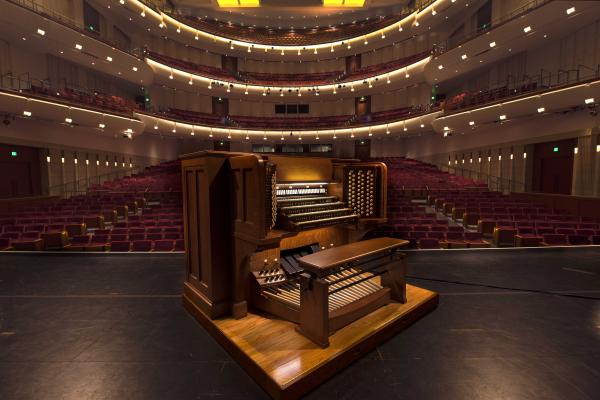
When the University of Minnesota installed a pipe organ in Northrop Auditorium, its 4,800-seat convocation hall, a wise choice was made; they got the best, an Aeolian-Skinner instrument (Opus 892) of four manuals, 6,982 pipes, and 108 ranks. Built in sections between 1932 and 1935, this was one of the largest instruments the company had built to that time, and it remains a remarkable document of a transitional period in the Aeolian-Skinner firm’s evolution. The organ retains much of the Ernest M. Skinner aesthetic, but some scaling and voicing details show the new influence of G. Donald Harrison.
Charles Courboin played the organ in Mahler’s Resurrection Symphony for Eugene Ormandy’s landmark 1932 recording with the Minneapolis Symphony, and the instrument made later cameo appearances with the orchestra under the baton of Antal Dorati in Respighi’s Church Windows and Roman Festivals, plus a few other selections.
By the 1970s, changes in fashion and lack of regular maintenance had left the organ unloved and in general disrepair. A comment onstage from Virgil Fox, presenting a Northrop concert with his electronic touring organ, spurred on a university music student, Gordon Schultz, to attempt some rehabilitative work. Schultz, who was apprenticed to the local M. P. Möller representative (and later took over that business), continued to minister to Opus 892 over the ensuing years, allowing the organ to be heard in regular and memorable, if not frequent, concerts during the next several decades. Some artists who performed at Northrop included Christoph Albrecht, Douglas Butler, Thomas Murray, Keith Chapman, and former University organist Edward Berryman.
When the university decided to give Northrop a major $88.2-million overhaul, Twin Cities organists and organ lovers banded together to ensure that the restoration of the organ was on the to-do list. In 2011, university funds paid for the careful removal and packing of the entire instrument by the Foley-Baker company, and F-B personnel also worked with the renovation architect and acoustician to ensure that the best possible situation would exist at such time as the pipe organ was reinstalled. Unfortunately, the overall project budget did not include any funds for the actual organ restoration, and when the renewed Northrop reopened in 2014 as a multi-use entertainment and academic venue, Opus 892 remained in storage.
Fortuitously, a specific $2.5-million bequest from the estate of university alumnus Dr. Roger E. Anderson provided the major funding for the $3.2-million reclamation project that took place over the past three years. All original chest components and pipes were shipped to the Foley-Baker workshop in Tolland, Connecticut, to be cleaned, repaired, releathered, refinished, and ultimately reinstalled. Though the original wooden console shell remains, all keyboards and controls are new, with stops configured in a manner identical to the originals. Installation in sections, according to the building’s schedule, took nearly two years. The process was completed in the late spring of 2018, which allowed ample time for troubleshooting.
Formerly the organ sound wafted down from the overhead chamber through an ornate plaster grill in the auditorium ceiling. Depending on the stops used, the effect could be either a delicate wisp of tone or like thunder and lightning from above. Now, the effect is comparable to the restorations of the Sistine Chapel ceiling or Chartres Cathedral; the transformation is considerable. Suddenly details that previously had been only vague references now are heard with clarity and precision, allowing the delicacy or incisiveness of the sound to be fully appreciated, a very different experience. Anyone who remembers Northrop’s organ from before will be surprised and delighted by the impression made now, because you surely can hear it from a much better perspective than was ever before possible. True, the organist still has the least satisfactory seat, but even that situation is much improved.
The official re-inauguration of Opus 892 took place over the weekend of October 12–13 with two evening concerts by the Minnesota Orchestra, who called the old Northrop Auditorium home between 1929 and 1974. Osmo Vänskä conducted the world-premiere of a new score by John Harbison, What Do We Make of Bach?, with Paul Jacobs as soloist, along with the seemingly obligatory Organ Symphony (Opus 78) by Saint-Saëns, for which the organ part was played by university professor Dean Billmeyer. Harbison’s brainy and intriguing new piece provided ample display of instrument and soloist, with plentiful dialogue and a well-integrated organ part within the orchestral texture. It met with a very friendly response, but Jacob’s solo encore, a dynamic and expressive interpretation of Bach’s A-Minor Fugue (BWV 543ii), brought the crowd to its feet.
To further explore the newly available tonal riches of Opus 892, a program entitled “An Intimate Introduction to the Northrop Organ” was arranged for Saturday morning. Introduced by Pipedreams host Michael Barone, several members of the Twin Cities Chapter of the American Guild of Organists presented varied and colorful repertoire by John Cook, Harold Darke, Edvard Grieg, Clarence Mader, Robert Prizeman, Edward Elgar, Henri Dallier, George Fairclough, Camille Saint-Saëns, and Leo Sowerby. Between 400 and 500 people came out to hear Laura Edman, Jacob Benda, Helen Jensen, Bill Chouinard, Melanie Ohnstad, and Dean Billmeyer put the Aeolian-Skinner through its paces. A two-hour afternoon “open console” made it possible for curious and brave organ fanciers to test play Opus 892.
On December 4 at 7:30 p.m., Nathan Laube plays the first solo concert on the organ. The program includes works by Liszt, Wagner, and Reubke, along with the premiere of two Preludes and Fugues by Henry Martin, commissioned by Pipedreams. For information: www.northrop.umn.edu/events/nathan-laube-concert.
Thanks and congratulations are due to Robert Bruininks, former University of Minnesota president who spearheaded the search for organ project funding, and to Michael Foley, Philip Carpenter, Michael McKeever, and Milovan Popovic of the Foley-Baker firm for attention to detail through the entire prolonged process. With their help, and that of many others, Opus 892 has successfully reinstated itself as one of three 108-rank instruments that share the title of second-largest-Minnesota-pipe organ. Welcome home! ν
Aeolian-Skinner Opus 892
1932–1935
GREAT
16′ Diapason
8′ First Diapason
8′ Second Diapason
8′ Third Diapason
8′ Flute Harmonique
8′ Gedeckt *
8′ Viola *
8′ Gemshorn
51⁄3′ Quint
4′ Octave
4′ Second Octave
4′ Flute *
31⁄5′ Tenth
22⁄3′ Twelfth
2′ Fifteenth
VII Plein Jeu *
IV Harmonics
16′ Contra Tromba *
8′ Tromba *
4′ Octave Tromba *
Chimes (Solo)
Harp (Ch)
Celesta (Ch)
* Enclosed
SWELL (enclosed)
16′ Bourdon
16′ Gemshorn
8′ Geigen Diapason
8′ Hohlflute
8′ Rohrflute
8′ Flauto Dolce
8′ Flute Celeste
8′ Salicional
8′ Voix Celeste
8′ Echo Gamba
8′ Echo Celeste
4′ Octave Geigen
4′ Flute
4′ Violina
22⁄3′ Twelfth
2′ Fifteenth
V Dolce Cornet
V Chorus Mixture
16′ Posaune
8′ French Trumpet
8′ Cornopean
8′ Oboe
8′ Vox Humana
4′ Clarion
Tremolo
Harp (Ch)
Celesta (Ch)
CHOIR (enclosed)
16′ Contra Viole
8′ Diapason
8′ Concert Flute
8′ Cor de Nuit
8′ Dulcet II
8′ Dulciana
8′ Unda Maris
4′ Flute
4′ Gemshorn
22⁄3′ Nazard
2′ Piccolo
13⁄5′ Tierce
11⁄3′ Larigot
III Dulciana Mixture
16′ Fagotto
8′ Trumpet
8′ Orchestral Oboe
8′ Clarinet
Tremolo
Harp
Celesta
SOLO (enclosed)
16′ Contra Gamba
8′ Flauto Mirabilis
8′ Gamba
8′ Gamba Celeste
8′ Aetherial Celeste II
4′ Orchestral Flute
4′ Octave Gamba
III Cornet de Viole
16′ Corno di Bassetto
8′ English Horn
8′ French Horn
8′ Tuba Mirabilis
4′ Tuba Clarion
Tremolo
Harp (Ch)
Celesta (Ch)
Chimes
PEDAL
32′ Double Open Diapason
32′ Sub Bourdon **
16′ Diapason
16′ Metal Diapason
16′ Diapason (Gt)
16′ Contra Basse
16′ Contra Gamba (Solo)
16′ Contra Viole (Ch)
16′ Bourdon
16′ Gemshorn (Sw)
16′ Echo Lieblich (Sw)
8′ Octave
8′ Cello
8′ Viole (Ch)
8′ Gedeckt
8′ Still Gedeckt (Sw)
51⁄3′ Twelfth
4′ Super Octave
4′ Flute
V Harmonics
32′ Bombarde
32′ Contra Fagotto (Ch)
16′ Trombone
16′ Posaune (Sw)
16′ Fagotto (Ch)
8′ Tromba
4′ Clarion
Chimes (Solo)
** Originally a resultant below GGGG; 7 new pipes added 2016 by Foley-Baker to complete the register.
Couplers
Swell to Pedal
Great to Pedal
Choir to Pedal
Solo to Pedal
Swell to Pedal 4
Choir to Pedal 4
Solo to Pedal 4
Pedal to Great 8 ***
Swell to Great
Choir to Great
Solo to Great
Swell to Choir
Solo to Choir
Solo to Swell
Great to Solo
Swell 16
Swell 4
Swell to Great 16
Swell to Great 4
Swell to Choir 16
Swell to Choir 4
Choir 16
Choir 4
Choir to Great 16
Choir to Great 4
Solo 16
Solo 4
Solo to Great 16
Solo to Great 4
Manual Transfer ***
Pedal Divide ***
All Pistons Next ***
All Swells to Swell
*** Additions by Foley-Baker 2016
Solid State Combinations by Classic Organ Works
18 General pistons
10 Great pistons
10 Swell pistons
10 Choir pistons
8 Solo pistons
6 Pedal pistons
300 memory levels per user; multiple users possible
Sequencer
Transposer


